Fearless Genius: The Digital Revolution in Silicon Valley 1985-2000 (26-50)
Good day!
We return to the story about the exhibition of the American photographer Dag Menyuz. The first part safely passed the sandbox, for which thanks to habravchanam, and as I promised, here it is a continuation.
I apologize in advance for the title of the post, I quote the name of the exposition and ask not to arrange holivary for the correct name of the Valley. Those who liked the first part will be no less interesting, the rest do not judge strictly, I have no goal for everyone to like the post. I write to those who can not get to the exhibition, too, heard the story told by Doug Menseuse.
By the way, at the end there will be links to several sources and a link to a photo in good quality.
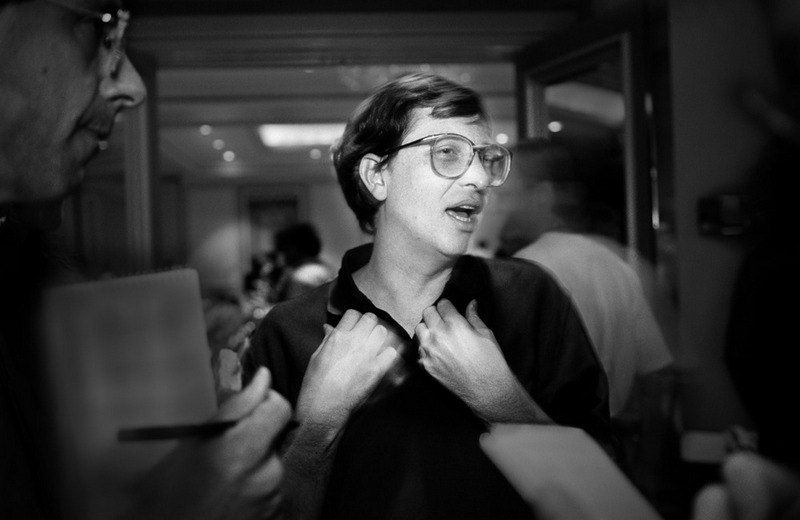
At Agenda'92, Microsoft Executive Director Bill Gates talks about accessible content and argues with reporters about the “phantom” Windows update being put off. The conference was organized by the scientist Stewart Alsop, who did not show any respect for Gates. In the same year, at an influential conference, Ted Gates reiterated his idea about the cost of a photo: "No one should pay more than fifty bucks for a photo." He completed the construction of a huge house in Seattle, in which he planned to install a screen showing an infinite number of images. This led to the idea of creating a photo bank of images, which was called the Continuum. But after the first contract of the photo bank was severely criticized for aggressively assigning rights in publications specializing in photography, the name was changed to Corbis.
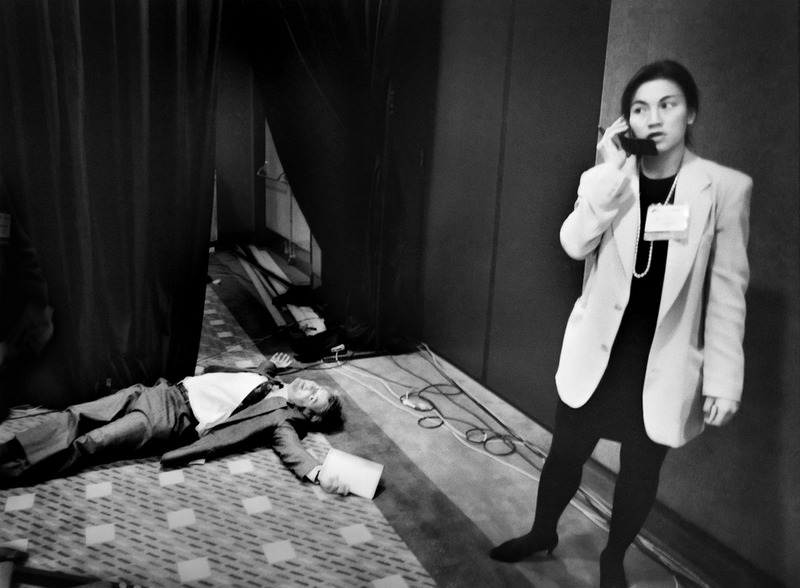
Unfortunately, while preparing for the Newton tablet presentation for the press in Las Vegas, the device broke down, causing event organizer Michael Wheatlin to fall to the floor, and Trisha Chan calling for help from the engineers. Apple promised that the tablet of their production will be able to solve the problem of organizing names, addresses and notes, as well as provide their holder with access to e-mail. John Scully gave the green light to the rebellious unit inside Apple, so that in inconceivable time to bring several untested technologies into one device that had no analogues on the market Scully hoped that Newton would rehabilitate him as a leader in new technologies. The device used a revolutionary method of handwriting recognition, based on the study of natural gestures. In fact, Apple had been working on it for several years, but was never able to solve this complex task. Until one day in 1987 in Moscow, the member of the Apple board of directors did not knock at the hotel door. The Russian engineer nervously handed him a disk containing a handwriting recognition program that Apple so desperately needs, and quickly left. This program has been included in Newton. Apple began delivering Newton before the program was completely ready, and basically did not work well. This led to public ridicule and criticism from Apple, as well as unimpressive sales — despite the fact that the product itself was brilliant overall. Newton was still being produced for a while, but when Steve Jobs returned to Apple, he destroyed it.
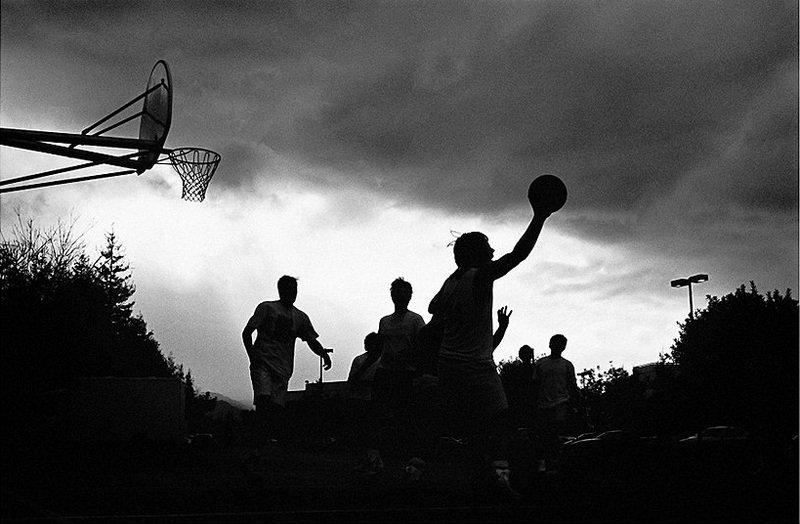
After a night's work, Apple Newton programmers play basketball before going back to the office. Today, leading technology companies provide indoor basketball courts, large cafes, kindergartens, medical care, massage, dry cleaning, travel and banking services for their employees. The initial attempt to make the heavy work schedule a little more humane took on an official character, although many still believe that all these privileges and conveniences are designed to make people work on campus longer.
')
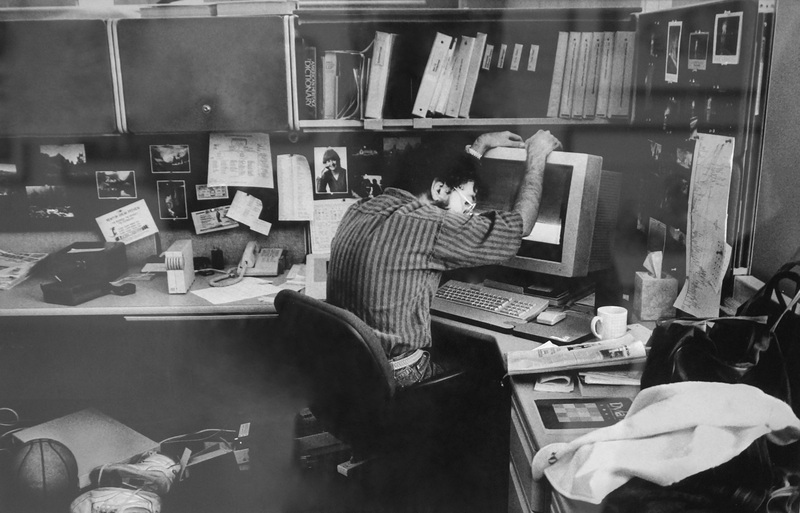
Programmer Peter Ellie rests after intensive work before the CES show in Chicago, where John Scully will present Apple Newton. Thirty programmers wrote millions of lines of code over the course of a year, but as yet nothing worked properly. Shortly after this photo was taken, the new board member Gaston Bastians, who was brought by John Sculley to bring Newton to the market, decided to switch to a new chip. Bastians demanded that the team rewrite a million lines of code and gave them another year to do this. Young programmer Ko Isono went home, loaded his gun and shot himself in the heart.

Commodity Marketing Specialist Joyce Gelbach wins James Joaquin (right) table football after a busy meeting with Apple Europe employees in Paris, which lasted a whole day. Despite the fact that Newton will enter the market only a year later, marketers made a world tour to bring him the attention of the press.
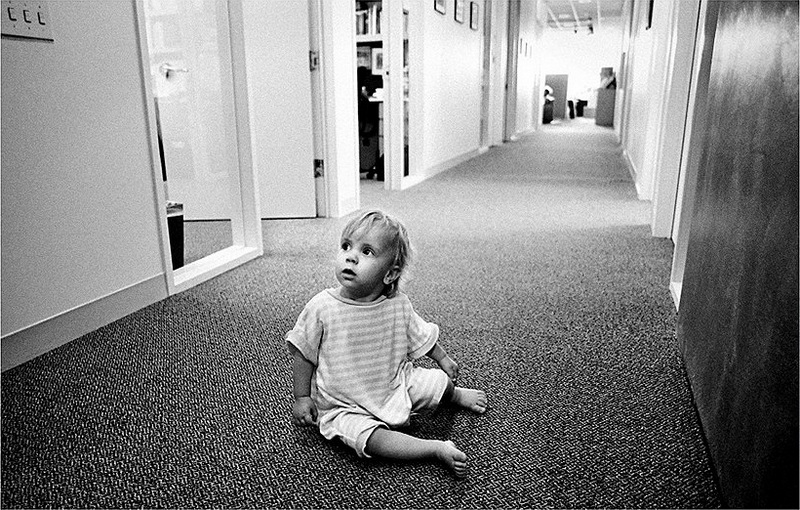
As the development team worked for days on end, including almost the entire weekend, they began bringing their wives, husbands, and children to the Apple office. Only in this way could children see their parents in daylight. Today, Apple employees also work very hard, especially if they are preparing new products for market entry.
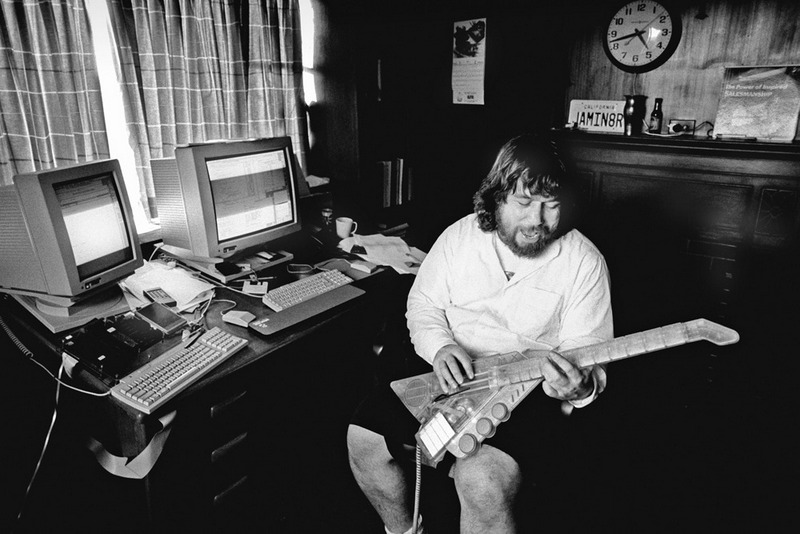
Steve Capps is a modest hero of Silicon Valley, one of the designers of the Macintosh Finder and the developers of the graphical user interface on which all the innovations of the interface of the last few decades are based. In the picture, he is at work at home on the software Network plays at home on Jaminator - he invented a digital guitar on which you can play everything: from your favorite solos to rock hits. Working twenty hours a day led to Steve starting to work from home, where I would sometimes appear and find him sleeping on a front porch mattress, often under the scorching morning sun. He said that he wanted Newton to be so intuitive that his mother could use it. Years later, Steve Jobs returned to Apple and destroyed Newton, transferring the main ideas of his device to the iPhone. Capps will later leave Apple, Microsoft.
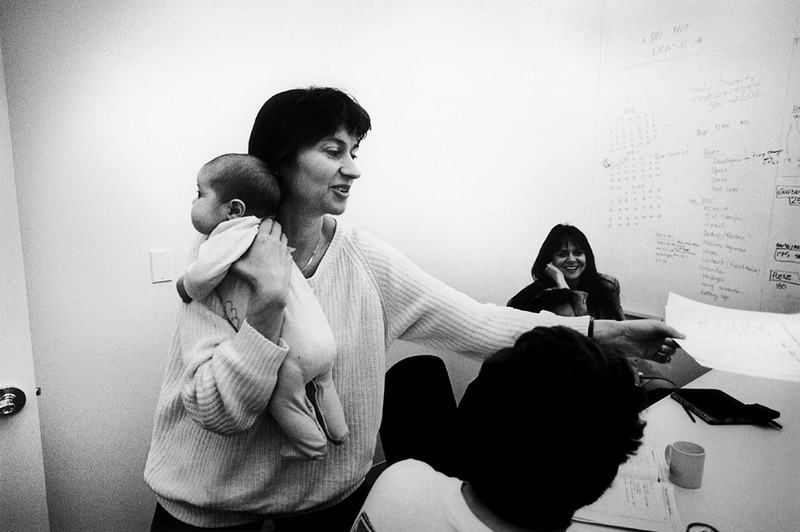
Apple programmer Sarah Clark brings a letter to the headquarters of Newton. Sarah kept her child at work, almost without leaving the building for two years, while the team was in a hurry to finish the software. She pulled the curtains in her office - and then her colleagues knew that it was a quiet hour or that she was breastfeeding. Her dedication to the company was typical of Apple employees and rewarded by management. A flexible schedule was adopted, as well as other favorable conditions for employees. John Scully appointed women to senior positions in Newton, which was unheard of in Silicon Valley.

Sharp's director, Akira Mitarai, thinks about the technology conference in Las Vegas about his company's role in the production of Apple Newton before speaking at a technology conference in Las Vegas. Sharp is increasingly convinced that Apple will not be able to finish the Newton software on time. In the end, these guesses were confirmed, because Apple did not meet the deadline and asked Sharp to urgently manufacture 4000 units to launch the product with a trial version of the software.

Behind the scenes before the press conference, members of the Newton team, Michael Tchao, Nazila Alasti, and Susan Schumann, discover that the many Newton modems they brought in for demonstration are broken. They hear the voices of hundreds of German journalists who have been blowing free beer for over an hour in anticipation of the promised new product and chanting “Newton! Newton. Tchao soon went on stage and began his speech, describing the broken Newton with the words "Imagine ..."
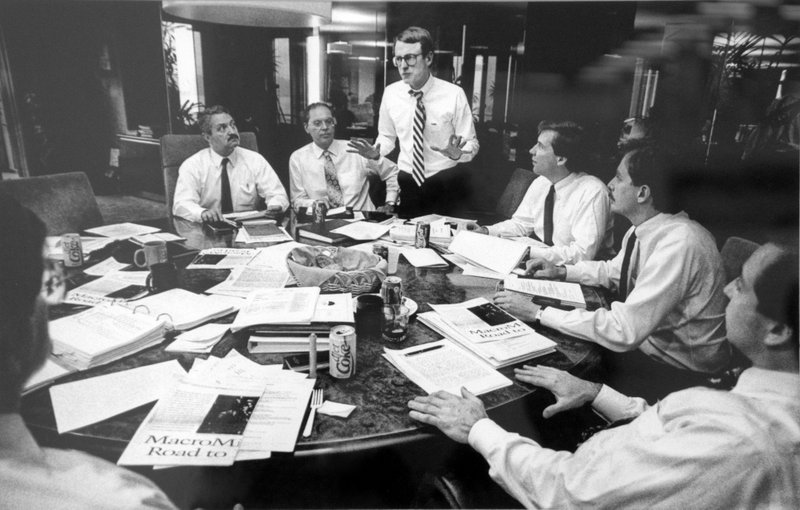
John Doerr proves his point during one of the famous Monday morning meetings, Kleiner Perkins Caulfield & Byers, where companies in which you can invest were usually discussed. Entrepreneurs give a blitz-resume of the company, or, as they say, they say “a speech in the elevator” (that is, the time for speech is given for as long as the journey takes place in the conditional elevator) - and hope for the best. They have already seriously invested in the first few Internet companies and are going to help launch Netscape, which started the dot.com gold rush. Kleiner Perkins remains a venture capital company with a legendary legacy. She invested and helped found a striking constellation of successful companies, including Genentech. Compaq, Sun Microsystems, AOL, At Home, Amazon.com and Netscape. Its partners include former Vice President Al Gore, General Colin Powell, William Randolph Hearst III, and Bill Joy, co-founder of Sun Microsystems.

This fun scene carries a subtle subtext not to go on vacation. As the Silicon Valley companies have gone from being children working in garages to technology giants, they began to adopt standard corporate practices, such as the provision of medical insurance and paid vacations. The Adobe System was doing very well, judging by their balance and the obvious happiness of the staff. However, working hours were long and the competition was fierce, so vacations were often postponed. And when someone was in a hurry and took a few days of vacation, which he actually deserved, he could find out on his return that there was a staff relocation in his office.

During his second election campaign, President Bill Clinton attended a fund-raising charity event organized by the executive directors of Silicon Valley. In the center of the picture is entrepreneur John Derr, who helped arrange a meeting at the house of the famous PR inventor Regis McKenna. He communicates with Clinton. During the dinner, guests showered Clinton with difficult issues related to new technology, commerce, and the economy. Patiently listening, the President smoothly consistently repelled their attacks, revealing amazing knowledge in all topics, even the little-known encryption technology. Each one pulled out his checkbook and generously donated to the campaign.
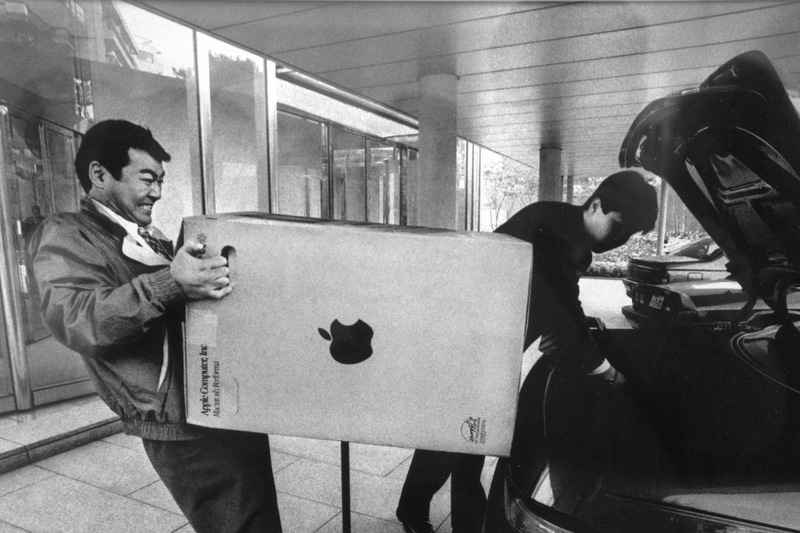
An Apple store salesman helpfully tries to load a new Macintosh into the buyer's car Macintosh immediately won a few but loyal fans around the world, especially in Japan.
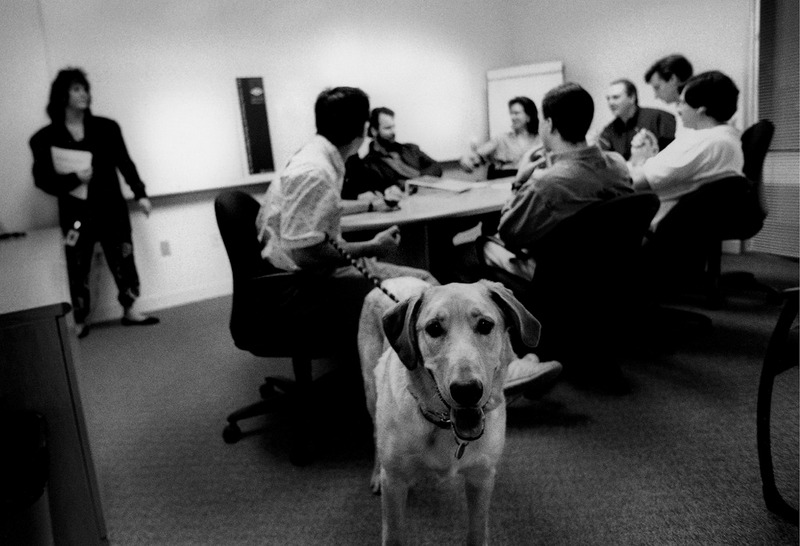
Autodesk was one of the first technology companies to allow their employees to keep pets at work: the workplace was adapted to the needs of people. Studies have shown that interaction with pets at work and at home normalizes the heartbeat.
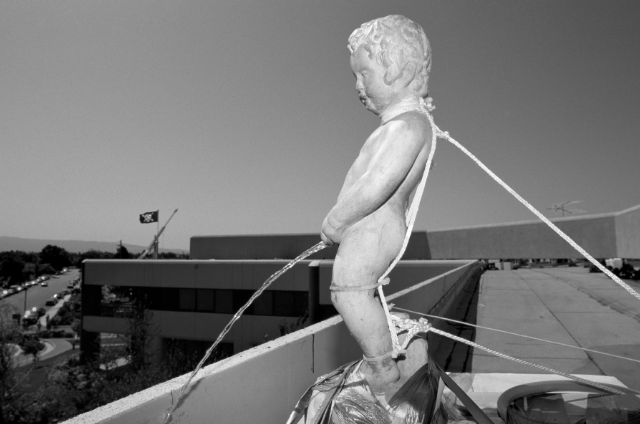
The famous boy peeing infinitely urinates down from the roof, where more than a thousand Sun Microsystems employees are involved in a water battle. The battle, which captured the entire space of the campus, is led by executive director Scott McNeillie and senior management, armed with sophisticated water guns. Thanks to an innovative workstation, Sun became the fastest growing technology company from 1985-1989.
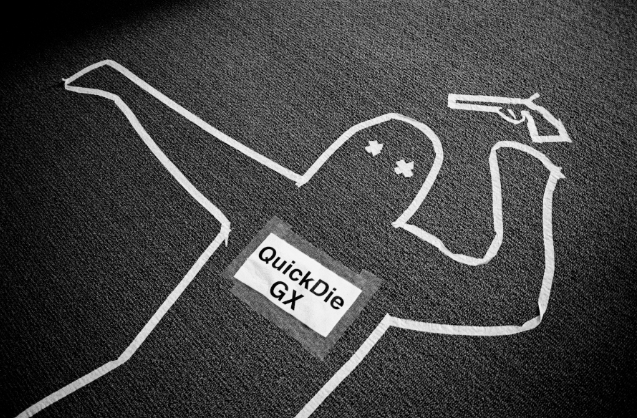
Although Macintosh was thought simple and easy to use, as it developed, it became more complex and difficult to manage. Users were angry and displaced discontent on technical support staff. In the center in Austin, one of the employees, desperate for the failures of QuickDraw, depicted this picture on the floor.
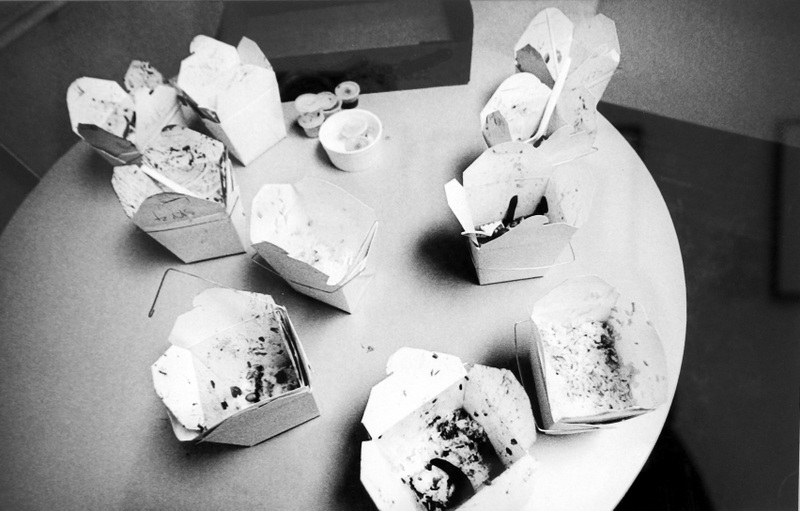
Empty Chinese food boxes were left by engineers who worked all night to complete an important version of the software at NetObjects headquarters. Launched in 1996 by Samir Arora and Clement Mock, NetObjects was the first company to create software that allowed everyone to create their own web page.
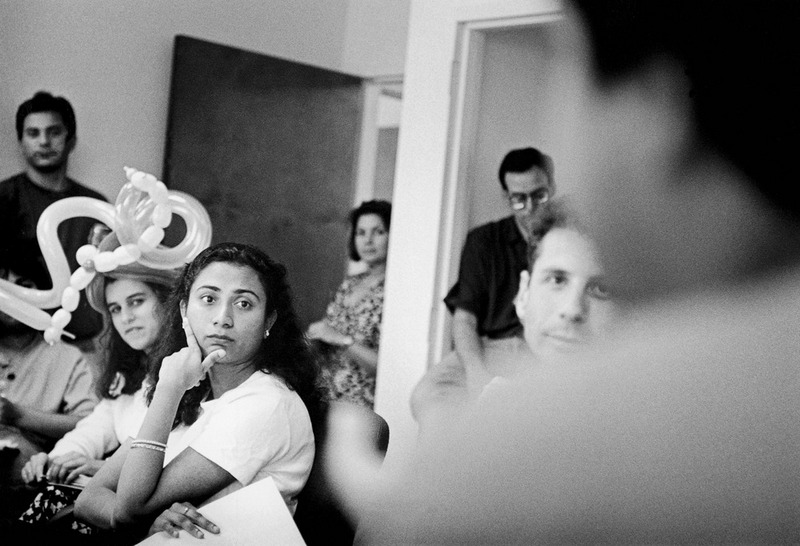
During a meeting of employees at NetObjects headquarters, its founder and CEO Samir Arora (out of focus) inspires his team to try to “assign” the design of a web page using software. As a small ritual, new employees were asked to put on hats from balloons. It was believed that this would help improve the communication of team members, which was important in a tense working atmosphere and disputes.
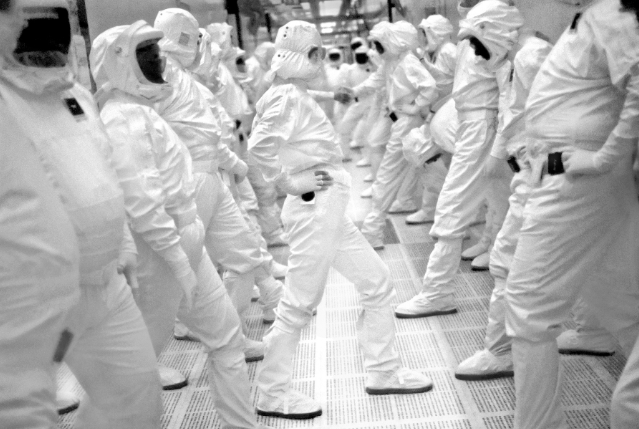
Workers inside Intel's largest chip factory train and stretch - this is the usual episode of their working break. They produce 5 chips per second, 24 hours a day. Most of the workers are from a neighboring Indian pueblo tribe who, after working with new technologies, lead a completely traditional lifestyle: they take care of corn and bean fields with their families. They helped Microsoft Windows become the main operating system, and today Intel chips run most computers. The company was founded by industry legends Gordon Moore and Robert Noyce, and Andy Grove became the first employee. Moore brought "Moore's Law", predicting that the number of transistors per chip will double every year. Andy Grove became CEO, and his leadership led Intel to incredible growth. He became a mentor for Steve Jobs when Steve was looking for a way out after being fired from Apple. Although Jobs hated Microsoft Windows and was not very happy that Intel supported Microsoft, he perceived the Pentium chip as a true innovation and called it the "coolest thing". Shortly after he came to power at Apple, he switched Apple computers to Intel chips.

The legendary programmer and co-founder of Sun Microsystems, Bill Joy, now believes that innovation for the sake of innovation threatens the very existence of humanity. In 2000, Bill published a manifesto in the magazine Wired, which stunned the world of technology and challenged the generally accepted perception of innovation as an absolute good. He warned that the interaction of the most powerful technologies of the 21st century - robotics, supercomputers, nanotechnologies and genetic engineering - will destroy humanity if their development is not put under tight control. When he was a student at Berkeley, he wrote the Berkeley Unix operating system, then he helped the US Department of War with a TCP / IP stack that made it easy to send and receive e-mail in the event of a nuclear war — and finished this code over the weekend. He then co-founded Sun Microsystems, a billionaire husband and father, patron of the arts. He also developed and helped complete the Java code. In the picture he is captured in Aspen, where he moved the office to get away from Silicon Valley. Nowadays, he returned to Silicon Valley as an entrepreneur investing in alternative energy sources at Kleiner Perkins.
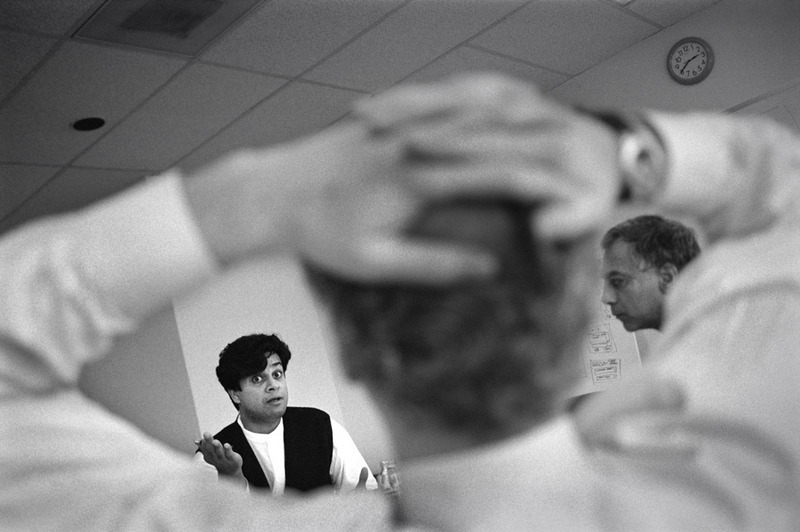
Samir Arora refuses to his business partners when they ask him to resign. A common case in Silicon Valley: the innovator and founder is pushed aside because of a lack of management experience or a controversial strategy. Almost every company goes through this, including Apple and Steve Jobs. It is incredible that Samir broke this tradition by refusing to give up his vision. Investors were furious and cut him off from financing, forcing Samir to tell 125 workers on Friday night that after four years of blood, sweat and tears, they were all fired. Samir went home and started calling every investor he knew - and by noon on Monday he had $ 10 million in the bank. NetObjects has been saved. Some time later, he sold it to IBM, bringing his investors 10,000% profit in three months. Success became more moderate in March 1999, when NetObjects became the first company in the history of the Internet with an IPO less than at the initial quote. CNN asked the question: "Will the dot.com bubble burst soon?" So it happened.
The exposition ended, but the most attentive readers noticed that the photos were not 50. This is true - the exhibition lacked three works. I don’t know the reasons, but there are 3 photos on the Internet which, possibly, are among the unrepresented. I leave signatures without translation.
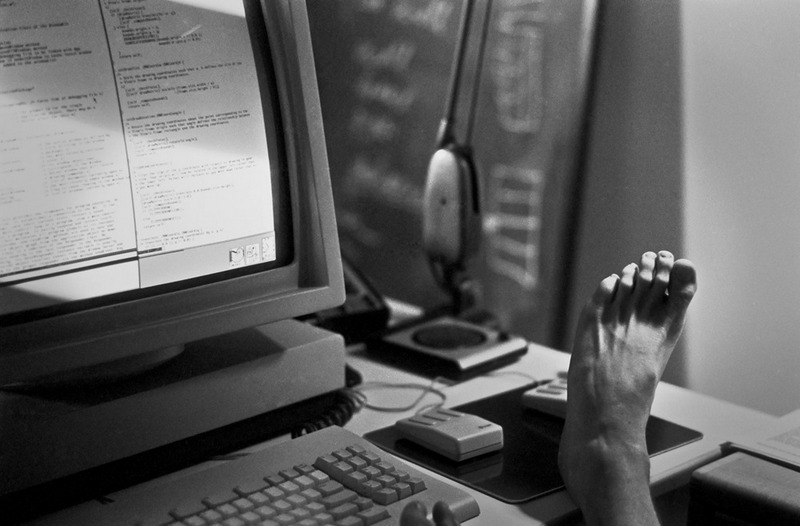

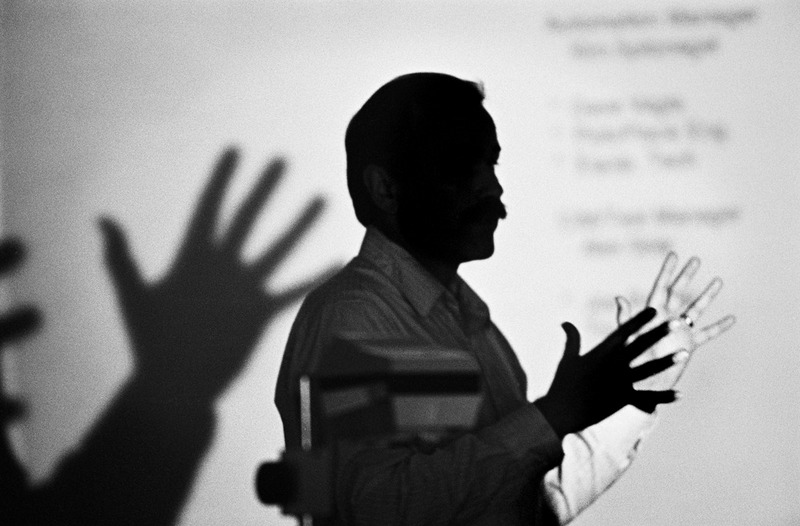
Thanks for attention! I apologize for having delayed the publication somewhat, I still have little experience and it is difficult to calculate the time for preparation. In addition, with my perfectionism, I will not allow myself to publish a fast post.
There are three galleries , two sites and a folder with used photos, in better quality I can post in a couple of days.
All the best!
We return to the story about the exhibition of the American photographer Dag Menyuz. The first part safely passed the sandbox, for which thanks to habravchanam, and as I promised, here it is a continuation.
I apologize in advance for the title of the post, I quote the name of the exposition and ask not to arrange holivary for the correct name of the Valley. Those who liked the first part will be no less interesting, the rest do not judge strictly, I have no goal for everyone to like the post. I write to those who can not get to the exhibition, too, heard the story told by Doug Menseuse.
By the way, at the end there will be links to several sources and a link to a photo in good quality.
Fearless Genius: The Digital Revolution in Silicon Valley 1985-2000
Doug menuez

Bill Gates declares: no one has to pay more than $ 50 for a photo in the future. Laguna Nigel, California 1992
At Agenda'92, Microsoft Executive Director Bill Gates talks about accessible content and argues with reporters about the “phantom” Windows update being put off. The conference was organized by the scientist Stewart Alsop, who did not show any respect for Gates. In the same year, at an influential conference, Ted Gates reiterated his idea about the cost of a photo: "No one should pay more than fifty bucks for a photo." He completed the construction of a huge house in Seattle, in which he planned to install a screen showing an infinite number of images. This led to the idea of creating a photo bank of images, which was called the Continuum. But after the first contract of the photo bank was severely criticized for aggressively assigning rights in publications specializing in photography, the name was changed to Corbis.

Preparation for the presentation is not so smooth. Las Vegas, 1992
Unfortunately, while preparing for the Newton tablet presentation for the press in Las Vegas, the device broke down, causing event organizer Michael Wheatlin to fall to the floor, and Trisha Chan calling for help from the engineers. Apple promised that the tablet of their production will be able to solve the problem of organizing names, addresses and notes, as well as provide their holder with access to e-mail. John Scully gave the green light to the rebellious unit inside Apple, so that in inconceivable time to bring several untested technologies into one device that had no analogues on the market Scully hoped that Newton would rehabilitate him as a leader in new technologies. The device used a revolutionary method of handwriting recognition, based on the study of natural gestures. In fact, Apple had been working on it for several years, but was never able to solve this complex task. Until one day in 1987 in Moscow, the member of the Apple board of directors did not knock at the hotel door. The Russian engineer nervously handed him a disk containing a handwriting recognition program that Apple so desperately needs, and quickly left. This program has been included in Newton. Apple began delivering Newton before the program was completely ready, and basically did not work well. This led to public ridicule and criticism from Apple, as well as unimpressive sales — despite the fact that the product itself was brilliant overall. Newton was still being produced for a while, but when Steve Jobs returned to Apple, he destroyed it.

Basketball at dawn Apple, Cupertino, California. 1992
After a night's work, Apple Newton programmers play basketball before going back to the office. Today, leading technology companies provide indoor basketball courts, large cafes, kindergartens, medical care, massage, dry cleaning, travel and banking services for their employees. The initial attempt to make the heavy work schedule a little more humane took on an official character, although many still believe that all these privileges and conveniences are designed to make people work on campus longer.
')

Million lines of code. Cupertino, California 1992
Programmer Peter Ellie rests after intensive work before the CES show in Chicago, where John Scully will present Apple Newton. Thirty programmers wrote millions of lines of code over the course of a year, but as yet nothing worked properly. Shortly after this photo was taken, the new board member Gaston Bastians, who was brought by John Sculley to bring Newton to the market, decided to switch to a new chip. Bastians demanded that the team rewrite a million lines of code and gave them another year to do this. Young programmer Ko Isono went home, loaded his gun and shot himself in the heart.

Apple Newton team in Paris 1992
Commodity Marketing Specialist Joyce Gelbach wins James Joaquin (right) table football after a busy meeting with Apple Europe employees in Paris, which lasted a whole day. Despite the fact that Newton will enter the market only a year later, marketers made a world tour to bring him the attention of the press.

Baby in Apple. Cupertino, California. 1993
As the development team worked for days on end, including almost the entire weekend, they began bringing their wives, husbands, and children to the Apple office. Only in this way could children see their parents in daylight. Today, Apple employees also work very hard, especially if they are preparing new products for market entry.

Steve Capps plays the Jaminator guitar. San Carlos. California. 1993
Steve Capps is a modest hero of Silicon Valley, one of the designers of the Macintosh Finder and the developers of the graphical user interface on which all the innovations of the interface of the last few decades are based. In the picture, he is at work at home on the software Network plays at home on Jaminator - he invented a digital guitar on which you can play everything: from your favorite solos to rock hits. Working twenty hours a day led to Steve starting to work from home, where I would sometimes appear and find him sleeping on a front porch mattress, often under the scorching morning sun. He said that he wanted Newton to be so intuitive that his mother could use it. Years later, Steve Jobs returned to Apple and destroyed Newton, transferring the main ideas of his device to the iPhone. Capps will later leave Apple, Microsoft.

Newton headquarters at Apple Computer Cupertino, California, 1993
Apple programmer Sarah Clark brings a letter to the headquarters of Newton. Sarah kept her child at work, almost without leaving the building for two years, while the team was in a hurry to finish the software. She pulled the curtains in her office - and then her colleagues knew that it was a quiet hour or that she was breastfeeding. Her dedication to the company was typical of Apple employees and rewarded by management. A flexible schedule was adopted, as well as other favorable conditions for employees. John Scully appointed women to senior positions in Newton, which was unheard of in Silicon Valley.

Akira Mitarai agreed that Sharp would produce Apple Newton. Las Vegas, 1993
Sharp's director, Akira Mitarai, thinks about the technology conference in Las Vegas about his company's role in the production of Apple Newton before speaking at a technology conference in Las Vegas. Sharp is increasingly convinced that Apple will not be able to finish the Newton software on time. In the end, these guesses were confirmed, because Apple did not meet the deadline and asked Sharp to urgently manufacture 4000 units to launch the product with a trial version of the software.

Imagine. Hannover, Germany, 1993
Behind the scenes before the press conference, members of the Newton team, Michael Tchao, Nazila Alasti, and Susan Schumann, discover that the many Newton modems they brought in for demonstration are broken. They hear the voices of hundreds of German journalists who have been blowing free beer for over an hour in anticipation of the promised new product and chanting “Newton! Newton. Tchao soon went on stage and began his speech, describing the broken Newton with the words "Imagine ..."

John Doerr and his partners discuss the future of the Internet Palo Alto, California, 1994
John Doerr proves his point during one of the famous Monday morning meetings, Kleiner Perkins Caulfield & Byers, where companies in which you can invest were usually discussed. Entrepreneurs give a blitz-resume of the company, or, as they say, they say “a speech in the elevator” (that is, the time for speech is given for as long as the journey takes place in the conditional elevator) - and hope for the best. They have already seriously invested in the first few Internet companies and are going to help launch Netscape, which started the dot.com gold rush. Kleiner Perkins remains a venture capital company with a legendary legacy. She invested and helped found a striking constellation of successful companies, including Genentech. Compaq, Sun Microsystems, AOL, At Home, Amazon.com and Netscape. Its partners include former Vice President Al Gore, General Colin Powell, William Randolph Hearst III, and Bill Joy, co-founder of Sun Microsystems.

Vacation Adobe System, Mountain View, CA, 1994
This fun scene carries a subtle subtext not to go on vacation. As the Silicon Valley companies have gone from being children working in garages to technology giants, they began to adopt standard corporate practices, such as the provision of medical insurance and paid vacations. The Adobe System was doing very well, judging by their balance and the obvious happiness of the staff. However, working hours were long and the competition was fierce, so vacations were often postponed. And when someone was in a hurry and took a few days of vacation, which he actually deserved, he could find out on his return that there was a staff relocation in his office.

President Clinton is really smart. Mountain View, CA, 1995
During his second election campaign, President Bill Clinton attended a fund-raising charity event organized by the executive directors of Silicon Valley. In the center of the picture is entrepreneur John Derr, who helped arrange a meeting at the house of the famous PR inventor Regis McKenna. He communicates with Clinton. During the dinner, guests showered Clinton with difficult issues related to new technology, commerce, and the economy. Patiently listening, the President smoothly consistently repelled their attacks, revealing amazing knowledge in all topics, even the little-known encryption technology. Each one pulled out his checkbook and generously donated to the campaign.

Apple Store. Tokyo 1995
An Apple store salesman helpfully tries to load a new Macintosh into the buyer's car Macintosh immediately won a few but loyal fans around the world, especially in Japan.

Dog in Autodesk. San Rafael, California. 1995
Autodesk was one of the first technology companies to allow their employees to keep pets at work: the workplace was adapted to the needs of people. Studies have shown that interaction with pets at work and at home normalizes the heartbeat.

Manneken Pis looks down at the water battle participants on the Sun Microsystems campus. Santa Clara, California 1995
The famous boy peeing infinitely urinates down from the roof, where more than a thousand Sun Microsystems employees are involved in a water battle. The battle, which captured the entire space of the campus, is led by executive director Scott McNeillie and senior management, armed with sophisticated water guns. Thanks to an innovative workstation, Sun became the fastest growing technology company from 1985-1989.

A cry for help from Apple’s technical support department. Austin, Texas 1996
Although Macintosh was thought simple and easy to use, as it developed, it became more complex and difficult to manage. Users were angry and displaced discontent on technical support staff. In the center in Austin, one of the employees, desperate for the failures of QuickDraw, depicted this picture on the floor.

Evidence of night programming. NetObjects, Redwood City, California, 1997
Empty Chinese food boxes were left by engineers who worked all night to complete an important version of the software at NetObjects headquarters. Launched in 1996 by Samir Arora and Clement Mock, NetObjects was the first company to create software that allowed everyone to create their own web page.

New employees should constantly wear hats from balloons. Redwood City, CA 1998
During a meeting of employees at NetObjects headquarters, its founder and CEO Samir Arora (out of focus) inspires his team to try to “assign” the design of a web page using software. As a small ritual, new employees were asked to put on hats from balloons. It was believed that this would help improve the communication of team members, which was important in a tense working atmosphere and disputes.

Break for a warm-up at the Intel Fab 11X factory. Rio Rancho, New Mexico, 1998
Workers inside Intel's largest chip factory train and stretch - this is the usual episode of their working break. They produce 5 chips per second, 24 hours a day. Most of the workers are from a neighboring Indian pueblo tribe who, after working with new technologies, lead a completely traditional lifestyle: they take care of corn and bean fields with their families. They helped Microsoft Windows become the main operating system, and today Intel chips run most computers. The company was founded by industry legends Gordon Moore and Robert Noyce, and Andy Grove became the first employee. Moore brought "Moore's Law", predicting that the number of transistors per chip will double every year. Andy Grove became CEO, and his leadership led Intel to incredible growth. He became a mentor for Steve Jobs when Steve was looking for a way out after being fired from Apple. Although Jobs hated Microsoft Windows and was not very happy that Intel supported Microsoft, he perceived the Pentium chip as a true innovation and called it the "coolest thing". Shortly after he came to power at Apple, he switched Apple computers to Intel chips.

Bill Joy worries about the future of humanity. Aspen, Colorado, 1998
The legendary programmer and co-founder of Sun Microsystems, Bill Joy, now believes that innovation for the sake of innovation threatens the very existence of humanity. In 2000, Bill published a manifesto in the magazine Wired, which stunned the world of technology and challenged the generally accepted perception of innovation as an absolute good. He warned that the interaction of the most powerful technologies of the 21st century - robotics, supercomputers, nanotechnologies and genetic engineering - will destroy humanity if their development is not put under tight control. When he was a student at Berkeley, he wrote the Berkeley Unix operating system, then he helped the US Department of War with a TCP / IP stack that made it easy to send and receive e-mail in the event of a nuclear war — and finished this code over the weekend. He then co-founded Sun Microsystems, a billionaire husband and father, patron of the arts. He also developed and helped complete the Java code. In the picture he is captured in Aspen, where he moved the office to get away from Silicon Valley. Nowadays, he returned to Silicon Valley as an entrepreneur investing in alternative energy sources at Kleiner Perkins.

Samir Arora intimidates his investors. Redwood City, CA, 1999
Samir Arora refuses to his business partners when they ask him to resign. A common case in Silicon Valley: the innovator and founder is pushed aside because of a lack of management experience or a controversial strategy. Almost every company goes through this, including Apple and Steve Jobs. It is incredible that Samir broke this tradition by refusing to give up his vision. Investors were furious and cut him off from financing, forcing Samir to tell 125 workers on Friday night that after four years of blood, sweat and tears, they were all fired. Samir went home and started calling every investor he knew - and by noon on Monday he had $ 10 million in the bank. NetObjects has been saved. Some time later, he sold it to IBM, bringing his investors 10,000% profit in three months. Success became more moderate in March 1999, when NetObjects became the first company in the history of the Internet with an IPO less than at the initial quote. CNN asked the question: "Will the dot.com bubble burst soon?" So it happened.
The exposition ended, but the most attentive readers noticed that the photos were not 50. This is true - the exhibition lacked three works. I don’t know the reasons, but there are 3 photos on the Internet which, possibly, are among the unrepresented. I leave signatures without translation.

NeXT Computer, Palo Alto, California, 1985

Susan Kare, NeXT Computer, Inc., Napa Valley, 1987

NeXT Computer, Inc. Offsite Meeting, Palo Alto, 1987
Thanks for attention! I apologize for having delayed the publication somewhat, I still have little experience and it is difficult to calculate the time for preparation. In addition, with my perfectionism, I will not allow myself to publish a fast post.
There are three galleries , two sites and a folder with used photos, in better quality I can post in a couple of days.
All the best!
Source: https://habr.com/ru/post/142064/
All Articles